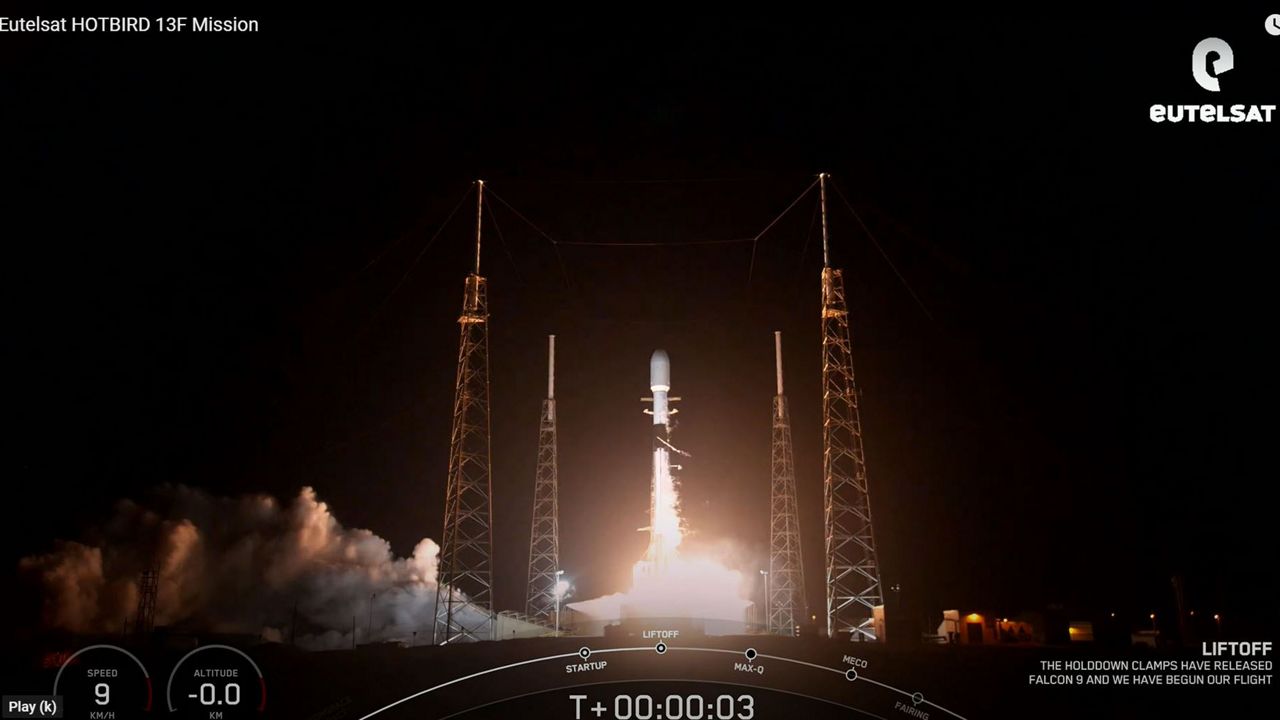CAPE CANAVERAL — After two delays, SpaceX was able to launch a European telecommunication satellite during the early morning hours on Saturday from the Space Coast.
What You Need To Know
- The launch was at 1:22 a.m. EDT, Saturday
- Eutelsat is a telecommunications company that provides television, internet
- Scroll down to learn more about the mission and to watch the launch
Liftoff! pic.twitter.com/2aK8VZGm3l
— SpaceX (@SpaceX) October 15, 2022
It has been a busy weekend for the company already: As the Crew-4 came down, the Hotbird 13F mission went up.
The joint NASA-SpaceX Crew-4 mission ended as the Crew Dragon spacecraft Freedom splash down off the coast of Jacksonville, Fla., late on Friday afternoon.
But as they came down back to Earth, SpaceX sent up the Eutelsat HOTBIRD 13F mission early Saturday morning.
Originally, it was scheduled for an 11:26 p.m. EDT launch on Friday, but SpaceX stated it moved the liftoff time to 12:26 a.m. EDT so it could review more data.
And then, SpaceX moved the launch time again to 1:22 a.m. EDT, the company stated in a tweet.
Now targeting 1:22 a.m. ET for launch of Eutelsat HOTBIRD 13F
— SpaceX (@SpaceX) October 15, 2022
Neither SpaceX nor Kate Tice, a quality engineering manager for the company who was hosting a live broadcast of the launch, gave a further explanation for the delay.
The company’s famed Falcon 9 rocket sent up the European telecommunication satellite from the Space Launch Complex 40 at Cape Canaveral Space Force Station.
The 116-minute launch window opened at 1:22 a.m. EDT, but there was a backup one set for Saturday at 11:26 p.m. EDT.
The 45th Weather Squadron gave a 90% chance of good launch weather as the satellites traveled to a geosynchronous transfer orbit.
Deployment of Eutelsat HOTBIRD 13F confirmed pic.twitter.com/R2t3PuOl8e
— SpaceX (@SpaceX) October 15, 2022
The booster for this mission, named B1069, has also sent up the CRS-24 in December 2021 and the Group 4-23 in August 2022.
Following the stage separation, the first stage landed on the droneship Just Read the Instructions that is out in the Atlantic Ocean.
Falcon 9’s first stage has landed on the Just Read the Instructions droneship pic.twitter.com/R4X0ClHlXk
— SpaceX (@SpaceX) October 15, 2022
It was the same SpaceX droneship that was used in the NASA-SpaceX Crew-5 mission.
Happening now: an @Airbus Beluga ST plane is arriving in Orlando. It's landing at @SFB_Airport this afternoon on its way to @NASAKennedy. Onboard is the @AirbusSpace-built #HOTBIRD 13G satellite for @Eutelsat_SA. 13F is launching tonight at 11:26 pm EDT.@MyNews13 #BelugaInUS pic.twitter.com/dDBoFYZ6qm
— Will Robinson-Smith (@w_robinsonsmith) October 14, 2022
About the mission
Eutelsat is a telecommunications company based in Paris, France, and provides television, internet and mobile communication services over most of Europe, the Middle East, Africa, Asia and the Americas.
The company created two satellites that will be sent up: The Hotbird 13F (which was sent up Friday night) and 13G (which will be launched in November of 2022). They will deliver 1,000 TV channels to more than 160 million homes in Europe, North Africa and the Middle East, stated the company.
These two satellites will be replacing three existing ones at the Hotbird flagship neighborhood at 13 degrees East, explained Tice who was at SpaceX’s headquarters in California.
Speaking of the Middle East, Eutelsat claimed that Iran has been jamming two of the company’s satellites.
“Since 26 September, Eutelsat has been experiencing jamming on two of its satellites. The interferences harmfully affect the transmission of several digital TV and radio channels broadcasting in Persian from outside of Iran, as well as other channels. As a result of measurements conducted with a specially designed interference detection system, Eutelsat concluded that the uplink transmissions of all these interfering carriers originated in Iran,” the company claimed in a press statement.
During the time of the alleged jamming, Iran was facing weeks of protests following the death of a woman who was in police custody.
Iran has not commented on the allegations.
Founded in 1977, Eutelsat has been working to bring satellite communications to Europe, with the company sending its first satellite EUTELSAT I-F1 into space in 1983.
Recently, the company announced a proposed merger with OneWeb, a communications company based in London that plans to build broadband satellite internet service.
“As a combined entity, OneWeb and Eutelsat will work together on the conception of OneWeb’s Gen 2 constellation, due to enter service by early 2028,” Eutelsat stated.
OneWeb’s internet satellites constellation is made in Merritt Island, Fla.
